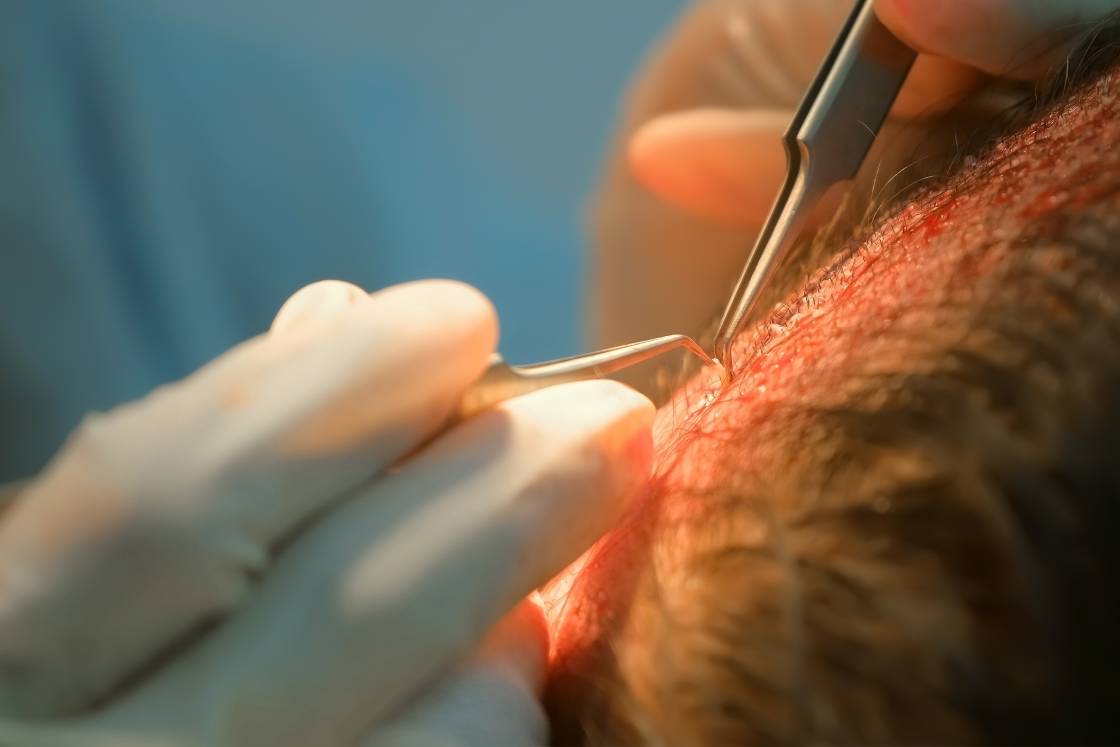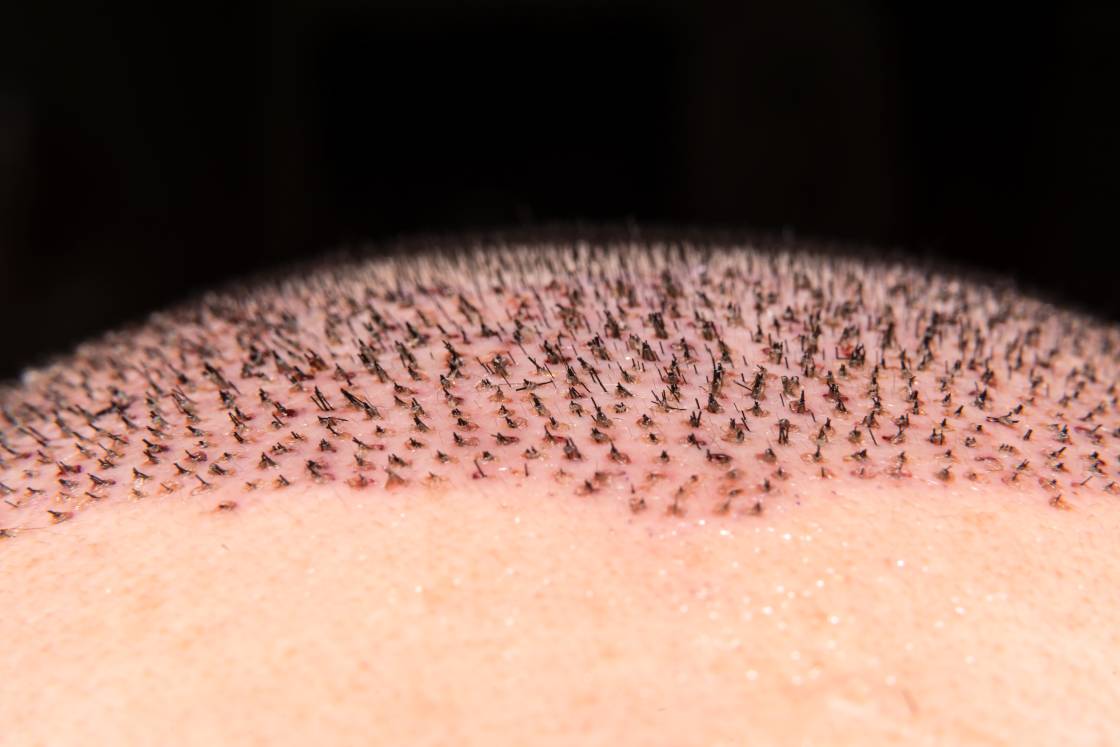Is a hair transplant painful? It is one of the patient’s most common questions to our hair transplant surgeons. FUE / DHI hair transplant is a comfortable procedure for most patients. After your scalp has been numbed with local anesthesia, you should not feel any pain during your procedure.
Many patients can be very anxious about potential pain, but here at Hairfix, we ensure they will be relaxed as possible. Today we will talk more about pain and having a hair transplant.
Tabla de Contenidos
How Painful Is A Hair Transplant?
A hair transplant surgery requires a specialist to make minor cuts to the scalp. All of us have pain nerves throughout the body and face, so when a surgeon cuts the skin, there can be a pain if these nerves are not stopped. In our scalp, there are many nerves, so these must be blocked with anesthesia. Our team of hair transplant doctor in Mexico is very aware of this, so they work on it using different techniques, such as:
- Using local anesthesia (with injections). The main technique that our surgeons use is local anesthesia (injections). These are small injections into the scalp to which the surgeon will take hair out and implant it. These injections are performed with a fine needle similar to human hair. Your entire scalp will be numb, and you shouldn’t feel pain.
- Giving pain-relieving medications. In addition to local anesthesia, our specialists will provide you with pain-relieving meds. These meds reduce any discomfort and help to relax you even further!
- Ensuring every patient is relaxed (since stress can increase pain). Being stressed increases the perception of pain, so keeping every patient calm and comfortable is one of our priorities. Our hair transplant clinic in Mexico is designed for this! You can ask to watch series or movies or listen to music!
At Hairfix, we ensure our patients feel calm, so we offer a relaxing massage on the legs during the implantation phase to reduce stress. If you want to find out about the experience of having a hair transplant with us, watch the video below!
Pain And Comfort During Hair Transplant
After your hair transplant, you will be given recovery instructions, and any discomfort you may feel will be easily controlled with simple and essential medications such as paracetamol and ibuprofen. Two days after the procedure, you will be pain-free and don’t require any other meds. Our surgeons will keep in contact with you to follow your case, meaning your recovery should go well with our specialist’s advice.
If you stay awake during your hair transplant, you are kept as comfortable as possible with any of your entertainment choices. By regaining your confidence at Hairfix, you can expect excellent attention regarding the patient’s comfort.
Which Hair Transplant Technique Is Less Painful?
At Hairfix, we use the latest technique for hair restoration, FUE / DHI hair transplant. This technique is painless compared to the FUT technique, which involves the removal of an entire strip of hair (from the back of your head); it is more invasive than FUE.
If you notice hair thinning or male pattern baldness and are currently looking for a painless procedure along with natural results. In that case, our DHI hair transplant is the solution to regain your confidence; here are the procedure steps:
- Donor Area Preparation. The doctor evaluates the donor area from which the hair will be extracted. Then, the hair in this area is trimmed to facilitate the identification and removal of hair.
- Extraction Phase. The follicles are extracted from the scalp with a specialized tool that, with only 1 mm in diameter, allows the hair to be removed safely, precisely, and without the risk of leaving scars.
- Implantation Phase. The extracted follicles are now implanted in the areas affected by baldness, such as the crown or sides. Our doctors control each implanted hair’s direction, depth, and angle, achieving natural-looking results.
- Healing And Hair Growth. In the first two weeks, following the post-op care instructions indicated by your doctor will be very important. After a month, you will fully recover, and from the 4th month onward, your hair will begin to grow. The final results of your hair transplant will be fully appreciated within 12 months.

Side Effects
A hair transplant is a minimally invasive surgical procedure that, like any other surgery, comes with potential risks and side effects. The most common ones include:
Redness and Swelling of the Scalp
Redness and swelling are completely normal after a hair transplant, both from the extraction and the implantation techniques. Thankfully, your specialist will prescribe pain relievers and anti-inflammatory medications to reduce discomfort and inflammation.
After the procedure, you should protect your head to avoid damaging the newly implanted follicles. It’s recommended to wear a loose-fitting hat, avoid direct sun exposure, and sleep with your head elevated to prevent friction.
Post-Treatment Bleeding
Bleeding is another common side effect following a hair transplant, usually affecting the donor area. Minor bleeding is normal during the first few days and can typically be managed by gently applying a clean gauze or cloth for a few minutes.
To avoid bleeding in the recipient area, be sure to follow your specialist’s post-op instructions and avoid taking blood thinners or anticoagulant medications.
Fortunately, this type of bleeding is usually mild and stops on its own within a day or two.
Itching After the Procedure
Itching is a normal side effect after a hair transplant. It’s part of the scalp’s healing and regeneration process. It usually starts within the first week after surgery and can last a couple of weeks until the healing is complete.
As tempting as it may be, avoid scratching or rubbing your scalp. Instead, apply the recommended products from your specialist to relieve the itching.
Scab Formation Around the Transplanted Follicles
Scab formation is also part of the normal healing process following a hair transplant. These scabs usually fall off on their own within 10 to 15 days. It’s important not to pick at or remove them, as this could interfere with healing and the growth of your transplanted hair.
Your specialist will recommend special shampoos and lotions to gently cleanse your scalp and soften the scabs, helping them fall off naturally without causing damage.

Temporary Hair Shedding (Telogen Effluvium)
Also known as “shock loss” or telogen effluvium, this is a natural, temporary reaction that typically occurs around one month after a hair transplant. It involves shedding of the transplanted hairs. While it may seem concerning, there’s no need to worry. This phase is completely normal, and the hair will grow back after a few weeks once the follicles stabilize.
In some cases, hair from non-transplanted areas may also shed, but it will typically grow back healthy over time.
Infection After a Hair Transplant
Infections after a hair transplant are rare, especially when patients follow their specialist’s instructions carefully. However, if they do occur, they can affect both the donor and recipient areas.
Common signs of infection include redness, bleeding, swelling, and a burning sensation. How can you tell if it’s an infection and not just a normal side effect? Typical side effects show up immediately after the procedure and gradually improve. In contrast, infection symptoms usually appear a few days after the transplant and tend to worsen over time. Fever often accompanies these signs.
If you experience any unusual symptoms, it’s important to contact your specialist right away.
Pain After A Hair Transplant
After your hair transplant, you will be given recovery instructions, and any discomfort you may feel will be easily controlled with simple and basic medications such as paracetamol and ibuprofen. Two days after the procedure, you will be pain-free and don’t require any other meds. Our surgeons will keep in contact with you to follow your case, meaning your recovery should go well with our specialist’s advice.
Does Pain Affect My Hair Transplant?
Pain should not affect your transplant. If you have severe pain, we recommend contacting our team of specialists, and they will assess you.
Give more volume to your life! If you notice that your hair is thinning and want to stop hair loss, our staff is here to help so you can regain your confidence. Our internationally prepared hair transplant surgeons have years of experience performing painless hair transplants! Ask us for Tijuana hair transplant and hair transplant cost Mexico and contact us to schedule an appointment.






